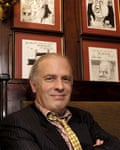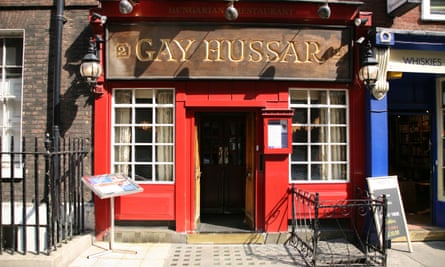For nearly two decades a series of irreverent political cartoons graced an entire wall of the celebrated Gay Hussar restaurant in London’s Soho – a snapshot of Westminster life that delighted tourists and regulars alike.
From Michael Foot’s distinctive white tresses to a glowering Alastair Campbell, the 63 caricatures of leading political figures drawn over lunch are now to be shared with a wider audience, thanks to a joint gift to the National Portrait Gallery by their creator Martin Rowson and Corus Hotels, which ran the Soho establishment until its closure in June 2018. A new restaurant opened on the site in September 2020.

“Individually they are worth little but as a collection I like to think that they have some historic merit and reflect an important period in our political life,” reflects Rowson. “This [the restaurant] was an extraordinary place where politicians mingled with journalists for lengthy, booze-fuelled lunches which would be unthinkable now. It was a hotbed of plotting, backstabbing, deal-making and gossip. The original idea behind the drawings was to capture a slice of that and later I thought it was important to try to keep them together.”
For 65 years - since opening in 1953 until its closure in 2018 – the Gay Hussar played host to generations of politicians, writers and artists with a Hungarian-style meaty menu that barely changed.

The black and white drawings were penned between 2000 and 2011 by Rowson, an award-winning political cartoonist, illustrator and self-confessed “ranter” known for his satirical and typically unflattering portraits.
Labour cabinet ministers, MPs, spin doctors, trade union barons and journalists from leftwing newspapers – including this one – who were regular diners, dominate the gallery of the great and not so good, while there is also a smattering of Tory MPs who flocked to the haunt.

Confirming the old adage that there’s no such thing as a free lunch, in 2000 Rowson – a devotee himself and attendee of the legendary dinners organised by Tribune magazine – had suggested to the restaurant’s manager, John Wrobel, that he should draw its “celebrity clientele”. The sitters were given a free meal in return and the drawings framed and displayed on the walls.
“They gradually replaced some plates and pictures of Hungarian peasants but we reached full capacity by 2005 and the rest migrated upstairs,” Rowson recalls.
All the drawings are dated and signed by the sitter even if not all – including one-time Guardian political editor Ian Aitken who declared his own image “insufficiently jolly” – were thrilled by the results.
Former Labour Party leader Michael Foot was the first subject in early 2000 – at the age of 88 still eating in the restaurant.
The era was known for the rise of New Labour following Tony Blair’s landslide election victory in May 1997. Blair’s spin doctor, Campbell – drawn in May 2002 – sat and glowered at Rowson with his arms crossed and declared at the end (with expletives) that the work looked more like Jeremy Paxman.
“What is disappointing is that there are so few women,” notes Rowson, which he admits could be down to an offputting blokey dining culture rather than a shortage of females in the Labour ranks.
Undeterred was cabinet minister Mo Mowlam, who made a necklace of chilli pepper table decorations during her sitting and fled in agony into the night after rubbing her eyes.
Rowson’s big regret is having not drawn veteran Labour MP and minister Barbara Castle who died before she was able to sit for him.

Rowson fears that trade unionists are in danger of being “forgotten by history”, lamenting the fact that the only portrait to have gone missing is that of veteran leader Jack Jones. He sketched him with his friend and fellow trade union heavyweight Rodney Bickerstaffe in 2002 as they downed champagne and absinthe.
The future of the collection had been plunged into doubt because of a lack of clarity about ownership. When the restaurant closed its doors in June 2018 its owner removed them and put them into storage for safe keeping.
Rowson and Corus Hotels each ran up legal fees as they sought to establish ownership but then called a truce and last year agreed to offer the collection to the National Portrait Gallery as a joint gift.
Paul Cox, curator at the National Portrait Gallery, said the NPG was extremely grateful for the “generous” gift and that it would be in good company.
“The Gay Hussar drawings follow the tradition of satirical caricature portraits of politics and social life established by artists such as James Gillray, who has over 800 works in the collection,” he said.
“They can also be seen as a collection of political portraits comparable with the gallery’s portraits of members of the [18th century] Kit-Cat Club by Sir Godfrey Kneller, which was also associated with an eating establishment – Christopher Cat’s tavern near Temple Bar, where he sold the mutton pies known as Kit-cats from which the club took its name.”
The drawings are now available for members of the public to view online, and may eventually be featured in exhibitions once the National Portrait Gallery – closed until 2023 for a major redevelopment – reopens.
Meanwhile the restaurant will this month celebrate its first anniversary under the management of the owners of Noble Rot wine bar in Bloomsbury.
